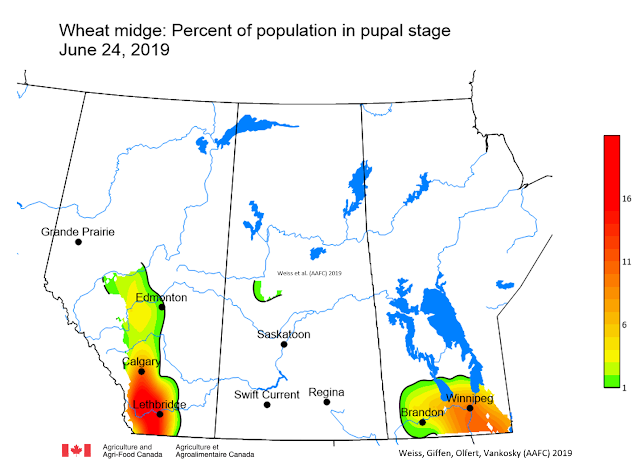Weather synopsis – Temperatures this week, June 18-24, 2019, were similar to last week. Over the past seven days temperatures were cooler than normal. The warmest temperatures were observed across MB while temperatures were cooler in western SK and across AB (Fig. 1). The is a complete reversal to last week.
 |
| Figure 1. Average temperature (°C) across the Canadian prairies the past seven days (June 16-24 2019). |
Average 30 day temperatures were warmest across southern MB and SK (Fig. 2). Cooler temperatures were reported across eastern and northern AB. The mean temperature differences from normal (May 21 – June 17, 2019) have been zero to two °C warmer than normal for AB and SK while temperatures in MB have been zero to two °C cooler than normal (Fig. 3).
 |
| Figure 2. Average temperature (°C) across the Canadian prairies the past 30 days (May 26-June 24 2019). |
 |
Figure 3. Mean temperature difference from Normal across the Canadian prairies over the past 30 days (to June 17, 2019).
|
Growing season temperatures (April 1-June 24, 2019) have been warmest across the southern prairies (Fig. 4). The warmest growing season temperatures have been reported for southern AB and an area south of Winnipeg MB. Across the prairies, the average growing season temperature has been 1.2 °C below normal.
 |
| Figure 4. Average temperature (°C) across the Canadian prairies for the growing season (April 1-June 24 2019). |
This past week significant rainfall amounts were reported for most of SK and across central regions of AB (Fig. 5). Across the prairies, rainfall amounts for the past 30 days (May 26 – June 24, 2019) have been near normal (Fig. 6). The Edmonton region has been the wettest.
 |
| Figure 5. Cumulative precipitation observed the past seven days across the Canadian prairies (June 18-24 2019). |
 |
| Figure 6. Cumulative precipitation observed the past 30 days across the Canadian prairies (May 26-June 24, 2019). |
Growing season rainfall (April 1 – June 24) amounts have been below average for most of the prairies, particularly across southern regions of AB (Fig. 7). Based on modeled soil moisture (Fig. 8), recent rains have improved soil moisture values across a large area of SK. Predicted soil moisture continues to be low across large regions of eastern MB and southern AB.
 |
| Figure 7. Cumulative precipitation observed for the growing season (April 1-June 24, 2019) across the Canadian prairies. |
 |
| Figure 8. Modeled soil moisture (%) across the Canadian prairies as of June 24, 2019. |
The growing degree day map (GDD) (Base 5 ºC, April 1-June 24, 2019) is below (Fig. 9):
 |
Figure 9. Growing degree day (Base 5 ºC) across the Canadian prairies for the growing season (April 1-June 24 2019).
|
The growing degree day map (GDD) (Base 10 ºC, April 1-June 24, 2019) is below (Fig. 10):
The lowest temperatures (°C) observed the past seven days ranged from about 11 to 0 °C in the map below (Fig. 11).
 |
Figure 11. Lowest temperatures (°C) observed across the Canadian prairies the past seven days (to June 24, 2019).
|
The highest temperatures (°C) observed the past seven days ranged from about 16 to at least 27 °C in the map below (Fig. 12).
 |
Figure 12. Highest temperatures (°C) observed across the Canadian prairies the past seven days (to June 24, 2019).
|
The maps above are all produced by Agriculture and Agri-Food Canada. Growers can bookmark the AAFC Drought Watch Maps for the growing season.

























